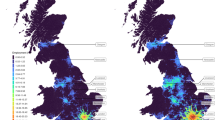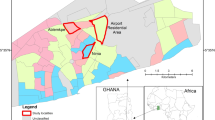Abstract
In response to changing consumer habits driven by the advance of online services and mobile apps, substantial reductions in the provision of bank branches have been widely documented over the last decade. Such closures have economic consequences for the sustainability of local businesses and the state of local high streets and may disproportionately affect demographic groups such as the elderly, those on low incomes, and those experiencing poor public transport and digital broadband connectivity. Geographical modelling can help to examine and better understand the impacts of bank closures, inform and guide future reductions, and contribute to impact assessment exercises. Many recent studies concerned with the spatial provision of services have adopted Floating Catchment Area techniques, exploring their use in a wide range of thematic and geographical contexts, but hitherto not to retail banking. This study documents the trialling of several approaches to the implementation of variable sized catchments within FCA tools in order to address previous concerns regarding the use of a fixed size catchment in study areas that encompass a wide range of settlement types. Findings suggest considerable potential in applying these tools to the banking sector, whilst also drawing attention to current limitations in the type of data available to differentiate settlement areas and guide parameter settings. However, with the future inclusion of supply-side measures such as branch opening hours and the incorporation of multi-modal travel, FCA tools can enhance existing impact assessment exercises and provide the public with greater confidence that the implications of bank branch closures have been fully considered.






Similar content being viewed by others
References
Access to Cash Review (2019) Access to Cash Review, Final report, available at: https://www.accesstocash.org.uk/ (last accessed, 31st July 2019).
Alamá, L., Conesa, D., Forte, A., & Tortosa-Ausina, E. (2015). The geography of Spanish bank branches. Journal of Applied Statistics, 42(4), 722–744.
Alama, L., & Tortosa-Ausina, E. (2012). Bank branch geographic location patterns in Spain: Some implications for financial exclusion. Growth and Change, 43(3), 505–543.
Argent, N. M., & Rolley, F. (2000). Financial exclusion in rural and remote New South Wales, Australia: A geography of bank branch rationalisation, 1981-98. Australian Geographical Studies, 38(2), 182–203.
Bauer, J., & Groneberg, D. (2016). Measuring spatial accessibility of health care providers – Introduction of a variable distance decay function within the floating catchment area (FCA) method. PLoS One, 11(7), e0159148. https://doi.org/10.1371/journal.pone.0159148.
Birkin, M., & Clarke, G. (1998). GIS, Geodemographics and spatial modelling in the UKk: Financial services industry. Journal of Housing Research, 9(1), 87–111.
Chakravarty, S. (2006). Regional variation in banking services and social exclusion. Regional Studies, 40(4), 415–428.
Chen, X., & Jia, P. (2019). A comparative analysis of accessibility measures by the two-step floating catchment area (2SFCA) method. International Journal of Geographical Information Science, 33(9), 1739–1758.
Dunham, I. M., & Foster, A. (2015). Proximate landscapes of economic inclusion in southeastern Pennsylvania. The Professional Geographer, 67(1), 132–144.
Financial Conduct Authority. (2018a). Strategic review of retail banking business models, Final report. London: FCA https://www.fca.org.uk/publication/multi-firm-reviews/strategic-review-retail-banking-business-models-final-report.pdf.
Financial Conduct Authority. (2018b). Strategic Review of Retail Banking Business Models, annexes to the final report. London: FCA https://www.fca.org.uk/publication/multi-firm-reviews/strategic-review-retail-banking-business-models-annex-reports.pdf.
French, S., Leyshon, A. and Meek, S. (2013) The changing geography of British Bank and building society branch networks, 2003–2012, Working Paper, University of Nottingham.
French, S., Leyshon, A., & Signoretta, P. (2008). “All gone now”: The material, discursive and political erasure of bank and building society branches in Britain. Antipode, 40(1), 79–101.
Guo, Y., Chee, H. C., & Yip, P. S. F. (2017). Spatial variation in accessibility of libraries in Hong Kong. Library and Information Science Research, 39, 319–329.
Hegerty, S. W. (2016). Commercial bank locations and “banking deserts”: A statistical analysis of Milwaukee and Buffalo. Annals of Regional Science, 56, 253–271.
Hegerty, S. W. (2020). "banking deserts," Bank branch losses, and neighborhood socioeconomic characteristics in the City of Chicago: A spatial and statistical analysis. The Professional Geographer, 72(2), 194–205.
House of Commons Library (2018) Bank Branch closures, Briefing Paper, Number 385, 19 October 2018. https://www.parliament.uk/commons-library (last accessed, 31st July 2019).
House of Commons Scottish Affairs Committee. (2018). Royal Bank of Scotland branch closures, third report of session 2017–19, HC 682. London: House of Commons.
Kashian, R. D., Tao, R., & Drago, R. (2018). Bank deserts in the USA and the great recession: Geography and demographics. Journal of Economic Studies, 45(4), 691–709.
Kiran, K. C., Corcoran, J., & Chhetri, P. (2020). Measuring the spatial accessibility to fire stations using enhanced floating catchment method. Socio-Economic Planning Sciences, 69, 100673.
Langford, M., Higgs, G., & Dallimore, D. (2019). Investigating spatial variations in access to childcare provision using network-based GIS models. Social Policy and Administration, 53(5), 661–677.
Langford, M., Higgs, G., & Fry, R. (2016). Multi-modal two-step floating catchment area analysis of primary health care accessibility. Health and Place, 38, 70–81.
Leyshon, A., French, S., & Signoretta, P. (2008). Financial exclusion and the geography of bank and building society branch closure in Britain. Transactions of the Institute of British Geographers, 33(4), 447–465.
Leyshon, A., & Thrift, N. (1995). Geographies of financial exclusion: Financial abandonment in Britain and the United States. Transactions of the Institute of British Geographers, 20, 312–341.
Luo, W., & Wang, F. (2003). Measures of spatial accessibility to health care in a GIS environment: Synthesis and a case study in the Chicago region. Environment & Planning B, 30, 865–884.
Luo, W., & Qi, Y. (2009). An enhanced two-step floating catchment area (E2SFCA) method for measuring spatial accessibility to primary care physicians. Health & Place, 15, 1100–1107.
Luo, W., & Whippo, T. (2012). Variable catchment sizes for the two-step floating catchment area (2SFCA) method. Health and Place, 18(4), 789–795.
Ma, X., Ren, F., Du, Q., Liu, P., Li, L., Xi, Y., & Jia, P. (2019). Incorporating multiple travel modes into a floating catchment area framework to analyse patterns of accessibility to hierarchical healthcare facilities. Journal of Transport and Health, 15, 100675.
Martin-Oliver, A. (2019). Financial exclusion and branch closures in Spain after the great recession. Regional Studies, 53(4), 562–573.
McGrail, M. R. (2012). Spatial accessibility of primary health care utilising the two step floating catchment area method: An assessment of recent improvements. International Journal of Health Geographics, 11, 50.
McGrail, M. R., & Humphreys, J. S. (2009a). Measuring spatial accessibility to primary care in rural areas: Improving the effectiveness of the two-step floating catchment area method. Applied Geography, 29(4), 533–541.
McGrail, M. R., & Humphreys, J. S. (2009b). A new index of access to primary care services in rural areas. Australian and New Zealand Journal of Public Health, 33, 418–423.
McGrail, M. R., & Humphreys, J. S. (2014). Measuring spatial accessibility to primary health care services: Utilising dynamic catchment sizes. Applied Geography, 54, 182–188.
Midgley, J. (2003). Access to financial services: moving beyond the spatial perspective. In G. Higgs (Ed.), Rural services and social exclusion (pp. 162–173). London: Pion Press.
Morrison, P. S., & O’Brien, R. (2001). Bank branch closures in New Zealand: The application of a spatial interaction model. Applied Geography, 21(4), 301–330.
National Assembly for Wales Economy, Infrastructure and Skills Committee (2019) Access to Banking, National Assembly, Cardiff. Available from www.assembly.wales/SeneddEIS (last accessed 22nd October 2019).
Naylor, K. B., Tootoo, J., Yakusheva, O., Shipman, S. A., Bynum, J. P. W., & Davis, M. A. (2019). Geographic variation in spatial accessibility of U.S. healthcare providers. PLoS ONE, 14(4), e0215016. https://doi.org/10.1371/journal.pone.0215016.
Office for National Statistics, (n.d.) 2011 rural/urban classification https://www.ons.gov.uk/methodology/geography/geographicalproducts/ruralurbanclassifications/2011ruralurbanclassification (last accessed 17th December 2019).
Ordnance Survey (2018a) Points of Interest https://www.ordnancesurvey.co.uk/business-government/products/points-of-interest (last accessed 17th December 2019).
Ordnance Survey (2018b) OS Open Roads https://www.ordnancesurvey.co.uk/business-government/products/open-map-roads (last accessed 17th December 2019).
Pollard, J. S. (1996). Banking at the margins: A geography of financial exclusion in Los Angeles. Environment and Planning A, 28, 1209–1232.
PostgreSQL Database Management System (2017). Version 10.11, October 2017. The PostgreSQL Global Development Group. URL: https://www.postgresql.org/ (last accessed, 30th November 2019).
PostGIS (2018). Version 2.5.1, November 2018. PostGIS Project Steering Committee. URL: https://postgis.net/ (last accessed, 30th November 2019).
pgRouting (2018). Version 2.6.2, December 2018, pgRouting Community. URL: https://pgrouting.org/ (last accessed, 30th November 2019).
Radke, J., & Mu, L. (2000). Spatial decomposition, modeling and mapping service regions to predict access to social programs. Geographic Information Sciences, 6, 105–112.
Simpson, W., & Buckland, J. (2016). Dynamics of the location of financial institutions: Who is serving the inner city? Economic Development Quarterly, 30(4), 358–370.
The Scottish Parliament Economy, Jobs and Fair Work Committee (2018) Bank closures: impact on local businesses, consumers and the Scottish economy.
Tischer, D., Evans, J. and Davies, S. (2019) Mapping the availability of case: A case study of Bristol’s financial infrastructure, Working Paper, Personal Finance Research Centre, University of Bristol.
Wang, F. (2012). Measurement, optimization, and impact of health care accessibility: A methodological review. Annals of the Association of American Geographers, 102, 1104–1112.
Wang, F., Luo, W. (2005). Assessing spatial and nonspatial factors for healthcare access: Towards an integrated approach to defining health professional shortage areas. Health & Place 11, 131–146.
Which? (2019) Bank branch closures: is your local bank closing? https://www.which.co.uk/money/banking/switching-your-bank/bank-branch-closures-is-your-local-bank-closing-a28n44c8z0h5 (last accessed, 31st July 2019).
Xing, L., Liu, Y., Wang, B., Wang, Y., & Liu, H. (2020). An environmental justice study on spatial access to parks for youth by using an improved 2SFCA method in Wuhan, China. Cities, 96, 102405.
Acknowledgements
This paper is based on Points of Interest [CSV geospatial] data Updated: March 2019. © Database Right/Copyright 2019. Using: EDINA Digimap Ordnance Survey Service, https://digimap.edina.ac.uk/, Downloaded: July 2018; OS Open Roads data set © Crown copyright and database right 2018.
Funding
Wales Institute of Social and Economic Data and Methods (WISERD) Civil Society, funded by ESRC Large Centres Grant (Grant number: ES/L009099/1).
Author information
Authors and Affiliations
Corresponding author
Ethics declarations
Conflict of Interest
The authors declare that they have no conflict of interest.
Additional information
Publisher’s Note
Springer Nature remains neutral with regard to jurisdictional claims in published maps and institutional affiliations.
Rights and permissions
About this article
Cite this article
Langford, M., Higgs, G. & Jones, S. Understanding Spatial Variations in Accessibility to Banks Using Variable Floating Catchment Area Techniques. Appl. Spatial Analysis 14, 449–472 (2021). https://doi.org/10.1007/s12061-020-09347-2
Received:
Accepted:
Published:
Issue Date:
DOI: https://doi.org/10.1007/s12061-020-09347-2




